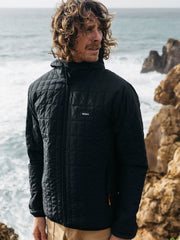On our recent trip to California, we had the pleasure of spending some time with Bonnie Tsui, author of Why We Swim. Below is a gripping excerpt from her book; telling the story of a man who should have drowned, saved by an odd biological quirk which had many calling him a real-life Selkie.
Why We Swim II
19.05.22
4 min read
Written by Bonnie Tsui
Image by David Gray
Down at the local - Keller Beach, San Francisco Bay...
One night over dinner, my husband tells me a story he heard about a boat in the North Atlantic and a man who should have drowned. Late on the evening of March 11, 1984, a fishing trawler was working on calm seas three miles east of the island of Heimaey, part of an archipelago off the south coast of Iceland. The sky was clear, the air a wintry twenty-eight degrees Fahrenheit.
There were five crew aboard the vessel. Guðlaugur Friðþórsson, the boat’s mate, was just twenty-two years old; he had taken a break and was asleep below deck when he was woken up by the cook, who told him the trawling gear had snagged on the sea bottom. Soon after Friðþórsson arrived on deck, he saw that the crew were trying to winch up the gear. One of the trawl wires was taut over the side, pulling the boat over so far that the sea had begun to wash through the railings. Friðþórsson shouted a warning. The captain, Hjörtur Jónsson, gave instructions to slacken the winch, but then it jammed. A swell ran under the boat, overturning it, and the sailors found themselves pitched into the freezing sea.
Two of the men drowned almost immediately, but the remaining three, including Friðþórsson, managed to grab hold of the boat’s keel. The vessel quickly began to sink, and they could not release the emergency raft. In the forty-one-degree water, they would have less than half an hour before hypothermia claimed them. The three began to swim toward the shore. Within minutes, only two remained: Jónsson and Friðþórsson.
The two men called to one other as they swam, to spur each other on. Then Jónsson stopped responding. Friðþórsson, wearing blue work pants, a red flannel shirt, and a thin sweater, kept swimming, and found himself talking to seagulls to stay awake. A boat came within three hundred and fifty feet of him and he shouted as loud as he could, but it sailed away. He swam backstroke, his eyes trained on the lighthouse at the southern end of the island. Eventually he heard the surf crashing on the coast. He prayed he would not get obliterated on the rocks. He found himself up against the base of a steep cliff, exhausted and terribly thirsty, unable to feel any of his extremities. With no way to climb up, he turned back to the sea, adjusted course, and swam farther south, where he came ashore and made his way slowly across a spiky, snow-covered lava field over a mile into town, stopping to punch through an inch-thick layer of ice on a sheep cistern to get a drink of water. When he finally arrived in town, it seemed to him a splendid dream-vision of life; he knocked on the door of the first home he saw with lights on. He was barefoot and covered in frost. Behind him was a trail of bloody footprints on the sidewalk leading up to the house.
“This man was more marine mammal than terrestrial. He had a biological quirk that saved him: it kept him warm, buoyant, and able to keep swimming.”
This is a true story. In the end, Friðþórsson survived six hours in frigid seas and swam more than three and a half miles to land. When he arrived at the hospital, doctors were unable to discern his pulse. And yet he showed no signs of hypothermia, only dehydration.
Friðþórsson’s body, it turns out, resembled a seal’s. Researchers later determined that he was insulated by fourteen millimeters of fat—two or three times the normal human thickness, and more solid. This man was more marine mammal than terrestrial. He had a biological quirk that saved him: it kept him warm, buoyant, and able to keep swimming. Many called him a real-life selkie—that half-man, half-seal figure of Icelandic and Scottish lore. To me, he is a living reminder that we are not so far removed from the sea.
As humans, we walk the earth. We are land creatures with an aquatic past. I’m drawn to stories like Friðþórsson’s because I want to know what remains of that past, today. In a way, all swimming stories—from the naiads of Greek myth to the long-distance swimmer Diana Nyad, who swam from Cuba to Florida in 2013—are attempts to reacquaint our land-adapted selves with water. We humans are not natural-born swimmers, but we have figured out ways to reclaim abilities that existed before that land-sea split in our evolution, hundreds of millions of years ago.
Why do we swim, when evolution has shaped us to excel on land by running down prey until it drops from exhaustion?
Of course it has to do with survival: Somewhere along the way, swimming helped us to get from one prehistoric lakeshore to another and escape predators of our own; to dive for that trove of bigger shellfish and get to new sources of food; to venture across oceans and settle new lands; to navigate all manner of aquatic perils and see swimming as a source of joy, pleasure, achievement. To arrive at this day, to talk about why we swim.


































































































